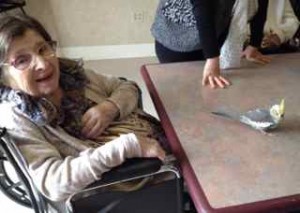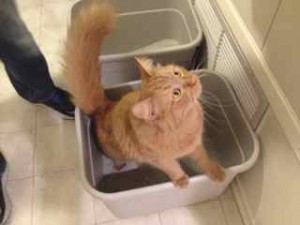
by Diane Masson | Mar 30, 2014
 It would be very interesting for independent, assisted living and group homes to share examples of people who moved into your senior living community who initially said, “No, I don’t want to leave my home!” How many senior living residents have you experienced in this situation?
It would be very interesting for independent, assisted living and group homes to share examples of people who moved into your senior living community who initially said, “No, I don’t want to leave my home!” How many senior living residents have you experienced in this situation?
Two weeks ago, I heard the story of an independent couple whose Boomer children moved them one hour closer to them. The dad said that he had left heel marks all the way up the freeway, because he didn’t want to move. Now, both he and his wife love living at their new Continuing Care Retirement Community that is located by their children and grandchildren.
Tonight, I heard about Jim and Joan’s dad. He was clinically depressed and stayed in his pajamas all day. He only put on clothes when Jim picked him up (drove him one block) to spend time with his wife and grandchildren. Once his dad, Dwayne, got to their house and had dinner, he didn’t want to leave, even at 11:00 PM. Jim and his wife Carol both had to be at work at 7:00 AM. They literally had to take a resistant Dwayne back to his home each evening. This went on every night for one year. Jim finally reached the breaking point.
Jim and his sister Joan went to find a retirement community for their dad. They had it all set up and then drove their dad to his new home. The entire way there, Dwayne kept saying, “No, no, no!” They said, “Dad, you will love it, give it a chance.” They showed him his new home and he was still resistant. Jim kept saying, “Dad, give it a chance,” and left. Two weeks later the dad was happier than he had been in his own isolated home. Dwayne spent five of the happiest years of his life there. Medication management and socialization had improved the quality of his life.
Nine years ago, my own mom was struggling (for over a year) in the independent living area of a Continuing Care Retirement Community. My sister, husband and I moved all my mom’s stuff to assisted living while her granddaughter took her to lunch. My daughter drove my mom back to her new home in assisted living. We were all there to greet them. My mom was shocked, but what could she do? We had moved her. It was done. The staff was all on board and had acclimated her before we left. Oh, the guilt I felt, but knew it was the right thing for her. We got a call in the night, because my mom had peed in a garbage can. Was it defiance or dementia? We will never know, but two weeks later she was happy and content. She steadily improved with three nutritious meals a day and medication management. My mom enjoyed seven years in that supportive environment.
Is it mean to move someone saying no? Or is it the best thing in the world?
Please share your successes, failures or comment below to join the conversation and interact with other senior living professionals on what is currently being effective to increase occupancy on a nationwide basis.
Diane Twohy Masson is the author of “Senior Housing Marketing – How to Increase Your Occupancy and Stay Full,” available at Amazon.com with a 5-star rating. The book is required reading at George Mason University as a part of its marketing curriculum. Within this book, the author developed a sales & marketing method with 12 keys to help senior living providers increase their occupancy. Masson developed this expertise as a marketing consultant, sought-after blogger for senior housing and a regional marketing director of continuing care retirement communities in several markets. She has also been a corporate director of sales and a mystery shopper for independent living, assisted living, memory care and skilled care nursing communities in multiple states. Currently, Masson is setting move-in records as the regional marketing director of two debt-free Continuing Care Retirement Communities in Southern California – Freedom Village in Lake Forest and The Village in Hemet, California. Interestingly, this career started when she was looking for a place for her own mom and helped her loved one transition through three levels of care.
© Marketing 2 Seniors| Diane Twohy Masson 2013 All Rights Reserved. No part of this blog post may be reproduced, copied, modified or adapted, without the prior written consent of the author, unless otherwise indicated for stand-alone materials. You may share this website and or it’s content by any of the following means: 1. Using any of the share icons at the bottom of each page. 2. Providing a back-link or the URL of the content you wish to disseminate. 3. You may quote extracts from the website with attribution to Diane Masson CASP and link https://www.marketing2seniors.net For any other mode of sharing, please contact the author Diane Masson.

by Diane Masson | Mar 23, 2014

What Diane Is Reading
Success in sales coming from a good attitude. Negative news sells newspapers and TV commercials. News commentators get paid to glamorize fear and a collapsing world. Overcome this fear by turning off the news and feeding your brain with positive thoughts and energy.
- What book(s) are you currently reading?
- How often do you read?
- Is there a certain time of day that works best for you?
- Do you read one chapter a day or multiple chapters?
It seems like there are readers and nonreaders in the world. Do you have a friend who is always starting or finishing a great book? Hint: I bet they are more positive than your friends who don’t read regularly.
These are my current go to books for working in senior living:
“How to Win Friends and Influence People,” by Dale Carnegie. I have read this classic about five times, just finished it with one sales team and currently on part two, chapter one with another team. This is one of the greatest books ever.
“Live Your Life Like It Matters,” by Scott V. Black. This book has sparked ideas for me to create team sales meetings and most recently an entire marketing retreat. I just finished this book and the last two chapters are due for a team review in the next two weeks.
“The Sales Bible,” by Jeffrey Gitomer. I have read this great book twice, just selected it for our book review at two Continuing Care Retirement Communities and chapter one is due next week.
“How I Raised Myself From Failure to Success Through Selling,” by Frank Bettger. Another classic that I have read several times, currently assigned this to a successful senior living sales person to pull them out of rut and chapter one is due next week.
“Ego vs EQ,” by Jen Shirkani. I am really excited about this new book to improve myself and grow, just finished chapter one last night.
“Senior Housing Marketing – How to Increase Your Occupancy and Stay Full,” By Diane Masson (me). I just used excerpts from “Chapter 10 – Internal Customers – No need to worry about them, right? Wrong!” for a concierge/receptionist training. It is the best book for training new sales team members and can help all communities increase their occupancy.
Current personal books:
“The Better Part, A Christ-Centered Resource for Personal Prayer,” by John Bartunek, LC, THD. This is my daily bible reading with outstanding reflections.
“Los Angeles, San Diego and Southern California,” by Lonely Planet. This is a resource I use to travel through Southern California, since I have lived here less than two years. We are going to L.A. tomorrow for a Lakers game and wanted to learn what else that my husband and I could explore.
“The Jesuit Guide to Almost Everything – A Spirituality for Real Life,” by James Martin, SJ. A friend gave me this book for Christmas and I have been slowly absorbing the recommendations for simplifying my life for the past three months. This book has really helped me.
“Hotel on the Corner of Bitter and Sweet,” by Jamie Ford. Another friend let me borrow this book and I want to start it this weekend.
Typically I read my daily bible reflection daily, several chapters a week from my other personal books and one chapter a week from each of my books for work.
Would you be willing to share your current reading list or favorite books?
Please share your successes, failures or comment below to join the conversation and interact with other senior living professionals on what is currently being effective to increase occupancy on a nationwide basis.
Diane Twohy Masson is the author of “Senior Housing Marketing – How to Increase Your Occupancy and Stay Full,” available at Amazon.com with a 5-star rating. The book is required reading at George Mason University as a part of its marketing curriculum. Within this book, the author developed a sales & marketing method with 12 keys to help senior living providers increase their occupancy. Masson developed this expertise as a marketing consultant, sought-after blogger for senior housing and a regional marketing director of continuing care retirement communities in several markets. She has also been a corporate director of sales and a mystery shopper for independent living, assisted living, memory care and skilled care nursing communities in multiple states. Currently, Masson is setting move-in records as the regional marketing director of two debt-free Continuing Care Retirement Communities in Southern California – Freedom Village in Lake Forest and The Village in Hemet, California. Interestingly, this career started when she was looking for a place for her own mom and helped her loved one transition through three levels of care.
© Marketing 2 Seniors| Diane Twohy Masson 2013 All Rights Reserved. No part of this blog post may be reproduced, copied, modified or adapted, without the prior written consent of the author, unless otherwise indicated for stand-alone materials. You may share this website and or it’s content by any of the following means: 1. Using any of the share icons at the bottom of each page. 2. Providing a back-link or the URL of the content you wish to disseminate. 3. You may quote extracts from the website with attribution to Diane Masson CASP and link https://www.marketing2seniors.net For any other mode of sharing, please contact the author Diane Masson.

by Diane Masson | Mar 16, 2014

Do They Feel Harshly Criticized?
“Critique” and “evaluate” are two simple words but often misconstrued by the receiver.
In a recent team meeting, one department head described how one of her staff cries every time she tries to critique her. This makes it very difficult for this supervisor to work with her employee. The senior living team brainstormed together. Another department head said that it really should be called “evaluating performance” of the staff member and not critiquing.
It is the responsibility of supervisors in senior living communities to continually evaluate his or her residents and document everything (particularly in skilled nursing care, assisted living and memory care). It sounds so simple, yet when a supervisor starts evaluating the caregiver providing the care to the resident…it can be misinterpreted as harsh criticism.
Hopefully, supervisors continually critique themselves and try to improve their own coaching skills. How is a supervisor approaching an employee to administer an evaluation or yearly review? Everyone has different personalities and some supervisor’s direct approach can be confrontational to another personality type. Our marketing team just read, “How to Win Friends and Influence People,” by Dale Carnegie. It is an excellent book on how to interact with other employees. Evaluations should be capitalized on as a teaching opportunity, so the evaluated employee can continually improve.
Can you share how you evaluate your senior living employees? How do you handle an employee who reacts negatively and turns the performance improvement plan into a personal attack on them?
Please share your successes, failures or comment below to join the conversation and interact with other senior living professionals on what is currently being effective to increase occupancy on a nationwide basis.
Diane Twohy Masson is the author of “Senior Housing Marketing – How to Increase Your Occupancy and Stay Full,” available at Amazon.com with a 5-star rating. The book is required reading at George Mason University as a part of its marketing curriculum. Within this book, the author developed a sales & marketing method with 12 keys to help senior living providers increase their occupancy. Masson developed this expertise as a marketing consultant, sought-after blogger for senior housing and a regional marketing director of continuing care retirement communities in several markets. She has also been a corporate director of sales and a mystery shopper for independent living, assisted living, memory care and skilled care nursing communities in multiple states. Currently, Masson is setting move-in records as the regional marketing director of two debt-free Continuing Care Retirement Communities in Southern California – Freedom Village in Lake Forest and The Village in Hemet, California. Interestingly, this career started when she was looking for a place for her own mom and helped her loved one transition through three levels of care.
© Marketing 2 Seniors| Diane Twohy Masson 2013 All Rights Reserved. No part of this blog post may be reproduced, copied, modified or adapted, without the prior written consent of the author, unless otherwise indicated for stand-alone materials. You may share this website and or it’s content by any of the following means: 1. Using any of the share icons at the bottom of each page. 2. Providing a back-link or the URL of the content you wish to disseminate. 3. You may quote extracts from the website with attribution to Diane Masson CASP and link https://www.marketing2seniors.net For any other mode of sharing, please contact the author Diane Masson.

by Diane Masson | Mar 9, 2014

My Mom With Bird
My mom is 91 years old and has vascular dementia. She has slowly declined over the last nine years. Through my research, I can assume she is in one of the last two stages of dementia (there are seven). My mom has been in skilled nursing care for the last 9½ months and needs 100% assistance. The last thing that she could do on her own was feed herself.
Now she has dramatically declined in the last month and even needs assistance with eating. She is still a good eater, but does not have the cognition to eat on her own. It is too much work for her. Her short-term memory seems like it has decreased to about one-second.
Antipsychotic medications have reduced the amount and the intensity of her delusions, anxiety, crying and irritability. There have been medications added, increased and decreased in the last four months. It has been a balancing act to try to improve the quality of her emotions and cognition without having her become lethargic.
Now my mom’s memory loss has affected her ability to walk. At the last care conference meeting, we discussed the quality of her life and whether it is a good idea to try to make someone walk or not. It takes constant encouragement to get her walking and she keeps trying to sit down. I have advocated for the caregivers to keep trying to walk her daily. They never make her, but lots of encouragement can produce a walk to breakfast or lunch. By dinnertime, my mom’s Sundowners Syndrome with anxiety and crying make it impossible to walk her.
My mother seems confused and miserable when she walks and just wants to sit down. I want to try to decide in the next week, if I should just let advocacy regarding walking stop all together. In my opinion walking seems so important because it gets her circulation going and her memory seems to clear up. When the walking officially stops, the memory will for sure get worse. Maybe I just need to accept my mom is in the final stage of dementia and have her enjoy what she can…like playing with the new bird at the community.
Please share your successes, failures or comment below to join the conversation and interact with other senior living professionals on what is currently being effective to increase occupancy on a nationwide basis.
Diane Twohy Masson is the author of “Senior Housing Marketing – How to Increase Your Occupancy and Stay Full,” available at Amazon.com with a 5-star rating. The book is required reading at George Mason University as a part of its marketing curriculum. Within this book, the author developed a sales & marketing method with 12 keys to help senior living providers increase their occupancy. Masson developed this expertise as a marketing consultant, sought-after blogger for senior housing and a regional marketing director of continuing care retirement communities in several markets. She has also been a corporate director of sales and a mystery shopper for independent living, assisted living, memory care and skilled care nursing communities in multiple states. Currently, Masson is setting move-in records as the regional marketing director of two debt-free Continuing Care Retirement Communities in Southern California – Freedom Village in Lake Forest and The Village in Hemet, California. Interestingly, this career started when she was looking for a place for her own mom and helped her loved one transition through three levels of care.
© Marketing 2 Seniors| Diane Twohy Masson 2013 All Rights Reserved. No part of this blog post may be reproduced, copied, modified or adapted, without the prior written consent of the author, unless otherwise indicated for stand-alone materials. You may share this website and or it’s content by any of the following means: 1. Using any of the share icons at the bottom of each page. 2. Providing a back-link or the URL of the content you wish to disseminate. 3. You may quote extracts from the website with attribution to Diane Masson CASP and link https://www.marketing2seniors.net For any other mode of sharing, please contact the author Diane Masson.

by Diane Masson | Feb 9, 2014

Over Sharing?
Believe it or not, I heard a senior living sales person say, “My cat has diarrhea,” to a hot prospect.” They blew the sale, because the senior was so worried about the sick cat. Really?!!?
Do you accentuate the positive and eliminate the negative at your senior living community? Maybe you better check. It’s easy for senior living marketing people to over compensate and share what you do you do not offer. They are just trying to be helpful to the customer. They are not trying to sabotage sales and send seniors to the competitor.
Every retirement community has its strong points and weak points. It does not matter if you are brand new or 25 years old. Always showcase your strengths. Is this something that you teach your senior living advisors? How do they learn it? Don’t make an assumption that they will learn it by osmosis.
Here is an expert from a chapter in my book called, “ Never Say to the Customer.”
There is such a thing as being too honest with the customer with statements such as:
- “You were on my list to call today.”
- “You were on my schedule to be followed up with today.”
- Telling the customer we will retain 10%. Instead saying, “The entrance fee is 90% refundable to your estate.”
- NEVER EVER refer to people as “a sale!”
- Please don’t call them a “prospect” in their presence or to their face. They are all your “guests,” in this book; I have referred to them as “prospective guests.” Please note: The term “prospect” or “prospective guests” is meant for marketing and is only to be used in-house. In the prospect’s presence the term to use is “guest.” I might say, “Mrs. Jones, I have an appointment later with another “guest” who is interested in this two-bedroom apartment home with the view of the park.”
I have literarily had three different types of sales people in the last week say, “I am following up with you.” It makes me cringe. How about you?
Please share your successes, failures or comment below to join the conversation and interact with other senior living professionals on what is currently being effective to increase occupancy on a nationwide basis.
Diane Twohy Masson is the author of “Senior Housing Marketing – How to Increase Your Occupancy and Stay Full,” available at Amazon.com with a 5-star rating. The book is required reading at George Mason University as a part of its marketing curriculum. Within this book, the author developed a sales & marketing method with 12 keys to help senior living providers increase their occupancy. Masson developed this expertise as a marketing consultant, sought-after blogger for senior housing and a regional marketing director of continuing care retirement communities in several markets. She has also been a corporate director of sales and a mystery shopper for independent living, assisted living, memory care and skilled care nursing communities in multiple states. Currently, Masson is setting move-in records as the regional marketing director of two debt-free Continuing Care Retirement Communities in Southern California – Freedom Village in Lake Forest and The Village in Hemet, California. Interestingly, this career started when she was looking for a place for her own mom and helped her loved one transition through three levels of care.
© Marketing 2 Seniors| Diane Twohy Masson 2013 All Rights Reserved. No part of this blog post may be reproduced, copied, modified or adapted, without the prior written consent of the author, unless otherwise indicated for stand-alone materials. You may share this website and or it’s content by any of the following means: 1. Using any of the share icons at the bottom of each page. 2. Providing a back-link or the URL of the content you wish to disseminate. 3. You may quote extracts from the website with attribution to Diane Masson CASP and link https://www.marketing2seniors.net For any other mode of sharing, please contact the author Diane Masson.

 It would be very interesting for independent, assisted living and group homes to share examples of people who moved into your senior living community who initially said, “No, I don’t want to leave my home!” How many senior living residents have you experienced in this situation?
It would be very interesting for independent, assisted living and group homes to share examples of people who moved into your senior living community who initially said, “No, I don’t want to leave my home!” How many senior living residents have you experienced in this situation?



